1993 CHEVROLET LUMINA high beam
[x] Cancel search: high beamPage 10 of 324
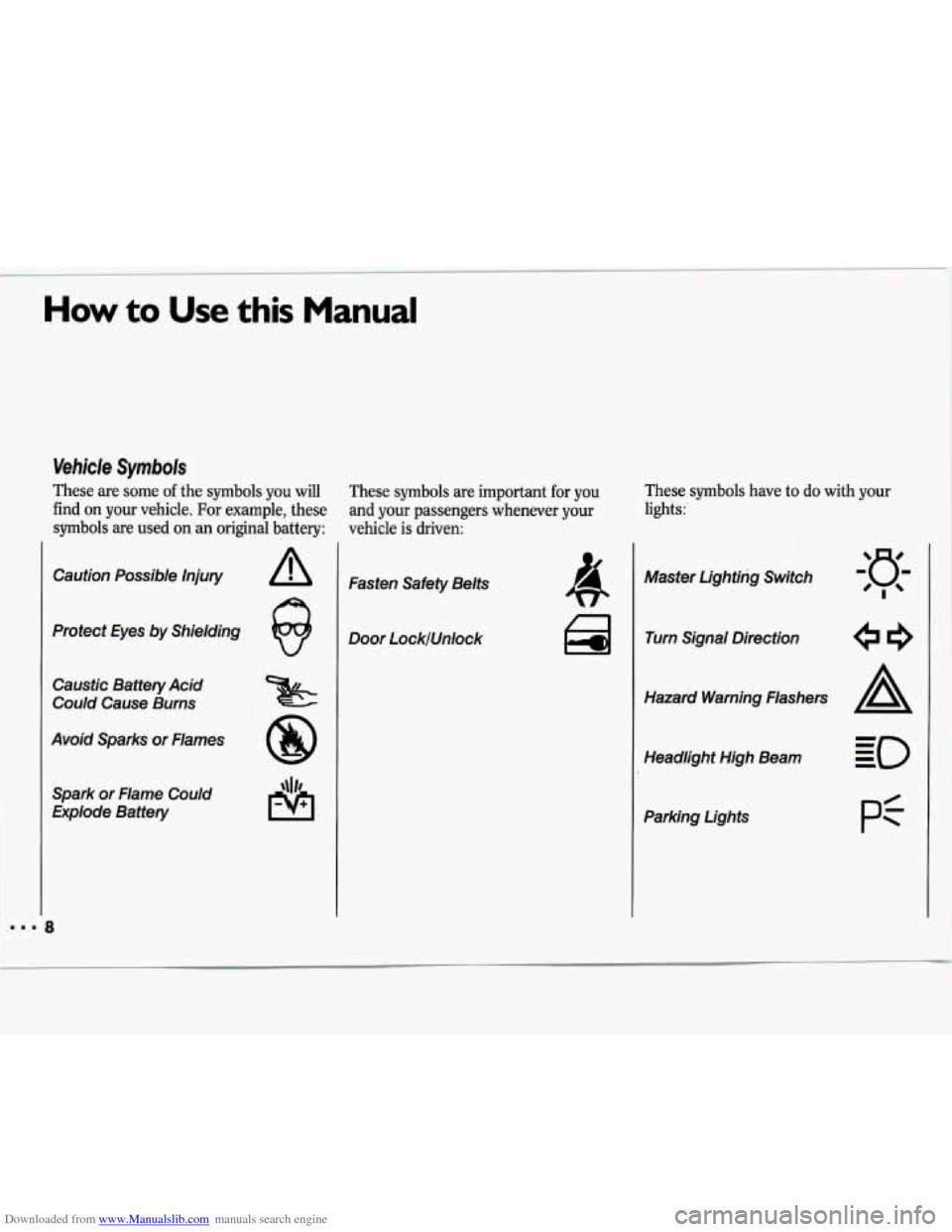
Downloaded from www.Manualslib.com manuals search engine How to Use this Manual
Vehicle Symbols
These are some of the symbols you will
find on your vehicle. For example, these
symbols
are used on an original battery: These symbols
are important for you
and your passengers whenever your
vehicle is driven: These
symbols have
to do with your
lights:
Caution Possible Injury
Protect
Eyes by Shielding
Caustic Battery Acid
Could Cause Burns
Avoid Sparks or Flames
Spark or Flame Could
Explode Battery Fasten Safety Belts
Door Lock/Unlock
la Turn Signal Direction
Hazard Warning Flashers
Headlight High Beam
Parking Lights
pf
Page 72 of 324

Downloaded from www.Manualslib.com manuals search engine Features & Controls
Turn Si'llHeadlight
Beam kver
The lever on the left side of the steering
column includes your:
Turn Signal and Lane Change
Headlight High-Low Beam
Windshield Wipers
Windshield Washer
Cruise Control (Option)
Indicator
Turn Signal and Lane Change
Indicator
The turn signal has two upward (for
Right) and
two downward (for Left)
positions. These positions allow you to
signal a turn or a lane change.
To Signal a Turn:
Move the lever all the way up or down.
When the turn is finished, the lever will
return automatically.
I
A green arrow on the instrument panel
will flash in the direction of the turn or
lane change.
To signal a lane change, just raise or
lower the lever until the green arrow
starts to flash. Hold it there until you
complete your lane change. The lever
will return by itself when you release it.
As you signal a turn or a lane change, if
the arrows don't flash but just stay
on, a
signal bulb may be burned out and
other drivers won't see your turn signal.
If a bulb is burned out, replace it to help
avoid an accident.
If the green arrows
don't go
on at all when you signal a
turn, check the fuse (see the
Index
under Fuses G. Circuit Breakers) and
for burned-out bulbs.
Page 79 of 324

Downloaded from www.Manualslib.com manuals search engine Headlights
The main light controls are on the left
side of the instrument panel. Push the
switch marked
pf to turn on your:
Parking Lights
Side Marker Lights
Taillights
License Plate Lights
Instrument Panel Lights
Push the switch again to turn them off. Push
the switch marked
-g- to turn on
your headlights, together with your:
Parking Lights
Side Marker Lights
Taillights
License Plate Lights
Instrument Panel Lights
Push the switch again to turn them off.
Operation of Lights
Although your vehicle’s lighting system
(headlamps, parking lamps, fog lamps,
side marker lamps and tail lamps) meets
all applicable federal lighting
requirements, certain states and
provinces may apply their
own lighting
regulations that may require special
attention before
you operate these
lamps. For example, some jurisdictions
may require that you operate your lower
beam lamps with fog lamps
at all times,
or that headlamps be turned on
whenever you must use your windshield
wipers. In addition, most jurisdictions
prohibit drively solely with parking
lamps, especially at dawn or
dusk. It is
recommended that you check with your
own state or provincial highway
authority for applicable lighting
regulations.
Lights On Reminder
If you open the door with the ignition
off and the lights on, you will hear
a
warning chime.
Page 80 of 324

Downloaded from www.Manualslib.com manuals search engine Features & Controls
Daytime Running Lights
(CANADA ONLY)
The Canadian Federal Government has decided that
Daytime Running Lights
(DRL) are a useful feature, in that DRL
can make your vehicle more visible to
pedestrians and other drivers during daylight hours. DRL are required
on
new vehicles sold in Canada.
Your DRL work with a light sensor on
top
of the instrument panel. Don’t
cover it up.
The low beam headlights will come
on
at reduced brightness in daylight when:
The ignition is on
The headlight switch is off, and
The parking brake is released. At dusk,
the exterior lights will come on
automatically and the low beams will
change to full brightness. At dawn, the
exterior lights will go out and the low
beams will change to the reduced
brightness of DRL (if the headlight
switch is
off).
Of course, you may still turn on the
headlights any time you need to.
To idle your vehicle with the
DRL off,
set the parking brake while the ignition
is in the
Off or Lock position. Then
start the vehicle. The DRL will stay
off
until you release the parking brake.
L I
c
Headlight High-Low Beam
Changer
I
To change the headlights from low
beam to high
or high to low, pull the
turn signal lever all the way toward you.
I
Then release it.
When the high beams are
on, a blue
light on the instrument panel also will
be on.
78
Page 140 of 324
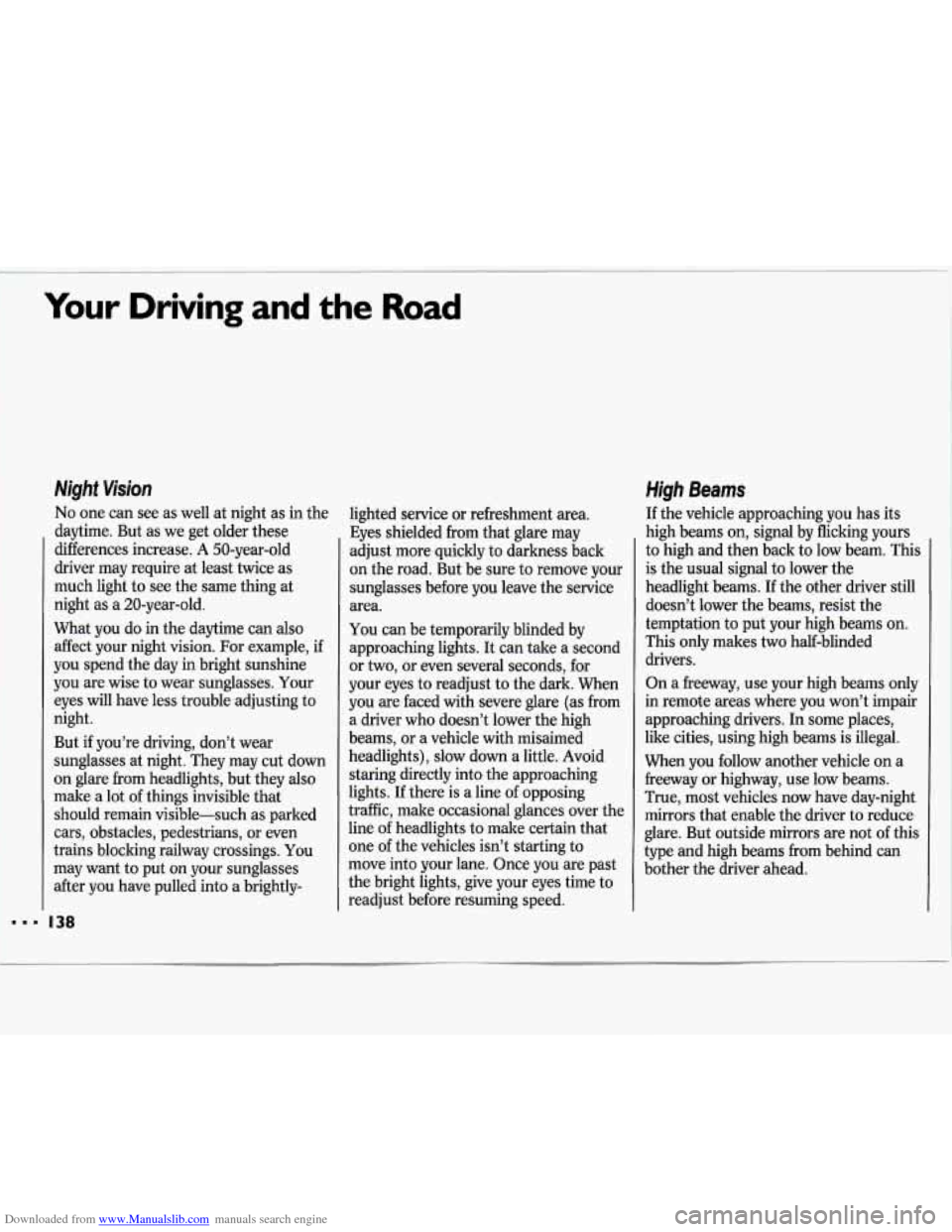
Downloaded from www.Manualslib.com manuals search engine I
Your Driving and the Road
Night Vision
No one can see as well at night as in the
daytime. But as we get older these
differences increase.
A 50-year-old
driver may require at least twice as
much light to see the same thing at
night as a 20-year-old.
What you do in the daytime can also
affect your night vision. For example,
if
you spend the day in bright sunshine
you are wise to wear sunglasses. Your
eyes will have
less trouble adjusting to
night.
But
if you’re driving, don’t wear
sunglasses at night. They may cut down
on glare from headlights, but they also
make a lot
of things invisible that
should remain visible-such as parked
cars, obstacles, pedestrians, or even
trains blocking railway crossings.
You
may want to put on your sunglasses
after you have pulled into a brightly-
I38
lighted service or refreshment area.
Eyes shielded from that glare may
adjust more quickly to darkness back
on the road. But be sure to remove your
sunglasses before you leave the service
area.
You can be temporarily blinded by
approaching lights. It can tale a second
or two, or even several seconds, for
your eyes to readjust to the dark. When
you are faced with severe glare (as from
a driver who doesn’t lower the high
beams, or a vehicle with misaimed
headlights), slow down a little. Avoid
staring directly into the approaching
lights. If there is a line
of opposing
traffic, make occasional glances over the
line of headlights to make certain that
one of the vehicles isn’t starting to
move into your lane. Once you are past
the bright lights, give your eyes time to
readjust before resuming speed.
High Beams
If the vehicle approaching you has its
high beams on, signal by flicking yours
to high and then back to low beam. This
is the usual signal to lower the
headlight beams. If the other driver still
doesn’t lower the beams, resist the
temptation to put your high beams on.
This
only makes two half-blinded
drivers.
On a freeway, use your high beams only
in remote areas where you won’t impair
approaching drivers.
In some places,
like cities, using high beams is illegal.
When you follow another vehicle on a
freeway or highway, use low beams.
True, most vehicles now have day-night
mirrors that enable the driver to reduce
glare. But outside mirrors are not
of this
type and high beams from behind can
bother the driver ahead.
Page 144 of 324
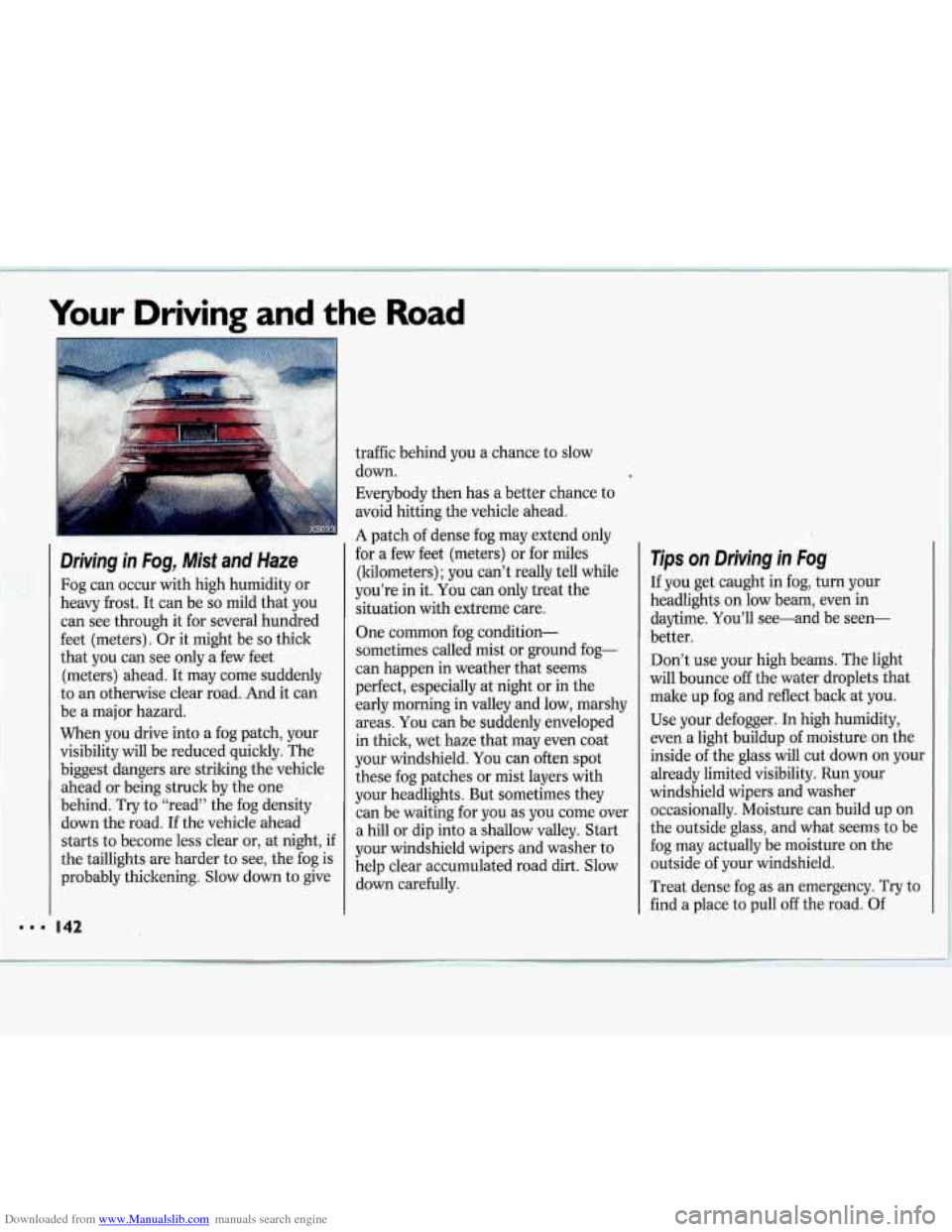
Downloaded from www.Manualslib.com manuals search engine Your Drivi r 2 the
A I
3 m
Driving in Fog, Mist and Haze
Fog can occur with high humidity or
heavy frost. It can be
so mild that you
can see through it for several hundred
feet (meters). Or it might be
so thick
that you can see only a few feet
(meters) ahead. It may come suddenly
to an otherwise clear road. And
it can
be
a major hazard.
When you drive into a fog patch, your
visibility will be reduced quickly. The biggest dangers are striking the vehicle
ahead or being struck by the one
behind.
Try to “read” the fog density
down the road. If the vehicle ahead
starts to become less clear or, at night, if
the taillights are harder to see, the fog is
probably thickening. Slow down to give traffic behind you
a chance
to slow
down.
Everybody then has a better chance to
avoid hitting the vehicle ahead.
A patch of dense fog may extend only
for a few feet (meters) or for miles (kilometers);
you can’t really tell while
you’re in it.
You can only treat the
situation with extreme care.
One common fog condition-
sometimes called mist or ground fog-
can happen in weather that seems
perfect, especially at night or in the
early morning in valley and low, marshy
areas.
You can be suddenly enveloped
in thick, wet haze that may even coat
your windshield.
You can often spot
these fog patches or mist layers with
your headlights. But sometimes they can be waiting for you as you come over
a hill or dip into a shallow valley. Start
your windshield wipers and washer to
help clear accumulated road dirt. Slow
down carefully.
Tips on Driving in Fog
If you get caught in fog, turn your
headlights on low beam, even in
daytime. You’ll see-and be seen-
better.
Don’t use your high beams. The light
will bounce
off the water droplets that
make up fog and reflect back at you.
Use your defogger. In high humidity,
even a light buildup of moisture on the
inside of the glass will cut down on your
already limited visibility. Run your
windshield wipers and washer
occasionally. Moisture can build up on
the outside glass, and what seems to be
fog may actually be moisture on the
outside of your windshield.
Treat dense fog as an emergency. Try to
find a place to pull off the road. Of
Page 253 of 324
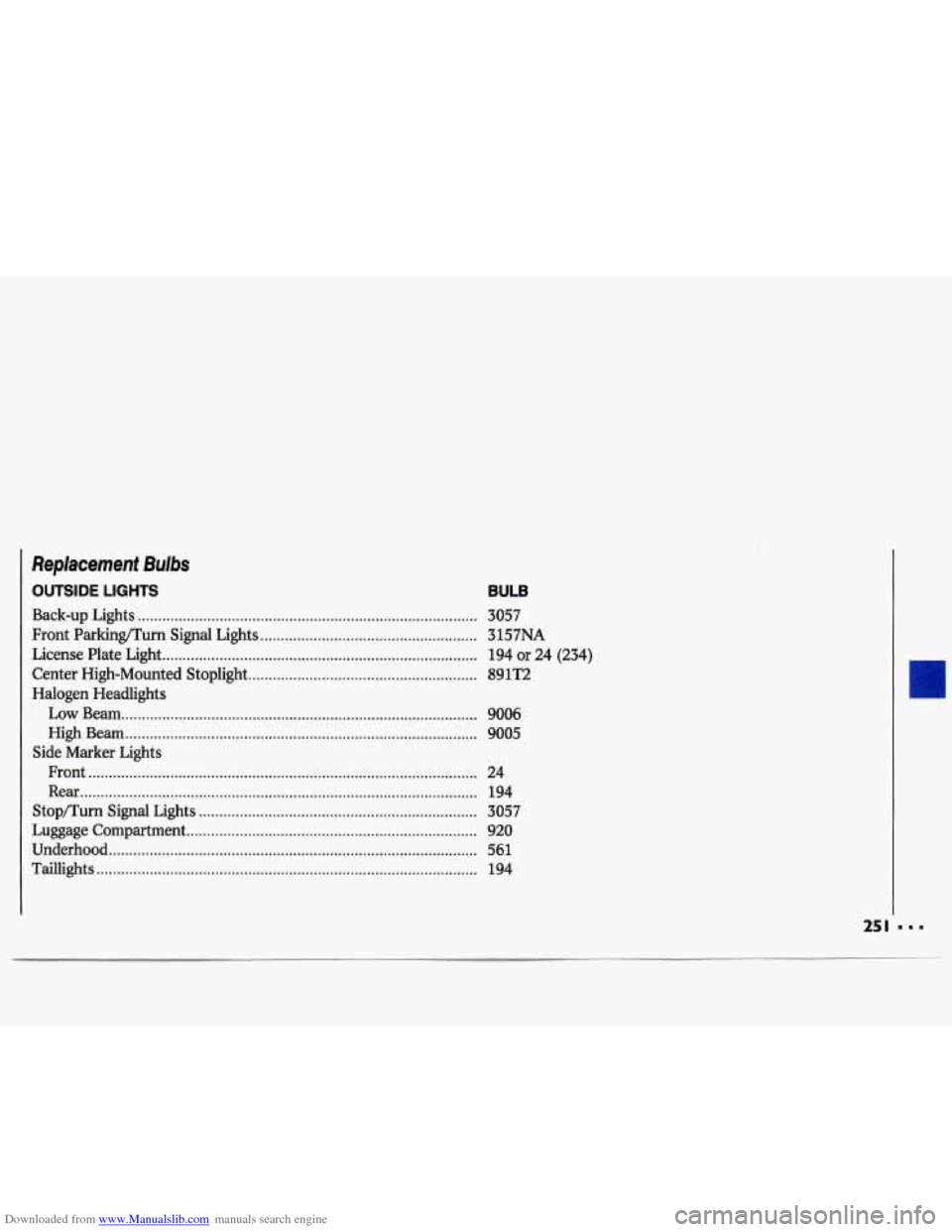
Downloaded from www.Manualslib.com manuals search engine Replacement Bulbs
OUTSIDE LIGHTS
Back-up Lights ........................................................................\
...........
Front Parkinflurn Signal Lights .....................................................
License Plate Light ........................................................................\
.....
Center High-Mounted Stoplight ........................................................
Halogen Headlights
Low Beam ........................................................................\
...............
High Be am ........................................................................\
..............
Front ........................................................................\
.......................
Rear ........................................................................\
.........................
Stop/Turn Signal Lights ....................................................................
Luggage Compartment ....................................................................... \
Underhood ........................................................................\
..................
Taillights ........................................................................\
.....................
Side Marker Lights
BULB
3057 3157NA
194 or 24 (234)
891T2
9006
9005
24 194
3057
920
561 194
Page 254 of 324
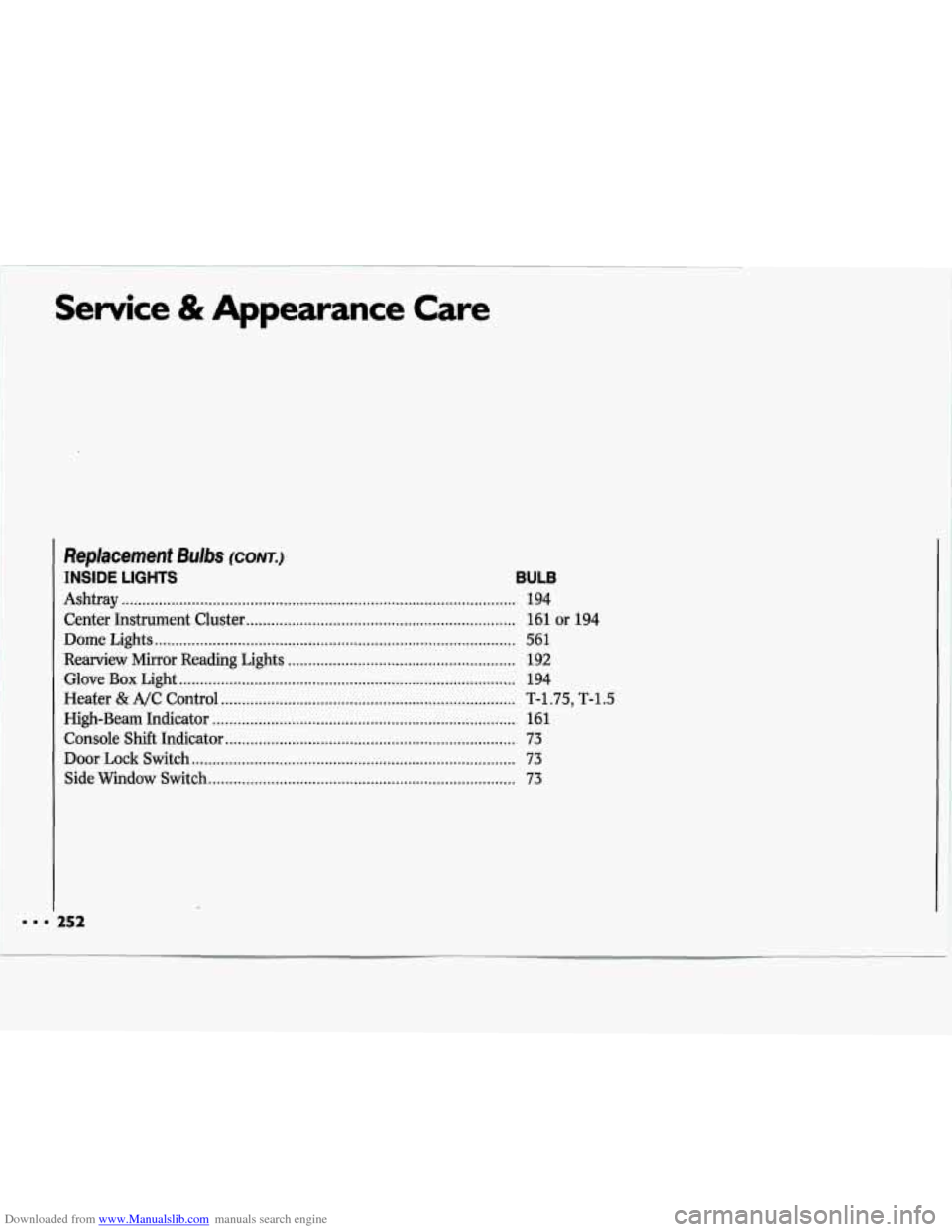
Downloaded from www.Manualslib.com manuals search engine Service & Appearance Care
Replacement Bulbs (CONT.)
INSIDE LIGHTS BULB
Ashtray ........................................................................\
.......................
Center Instrument Cluster .................................................................
Dome Lights ........................................................................\
...............
Rearview Mirror Reading Lights .......................................................
Glove Box Light ........................................................................\
.........
Heater & A/C Control ....................................................................... \
High-Beam Indicator ........................................................................\
.
Console Shift Indicator ......................................................................
Door Lock Switch ........................................................................\
......
Side Window Switch ........................................................................\
..
. 252
194
161 or 194
561 192
194
T-1.75, T-1.5
161
73
73
73
I'